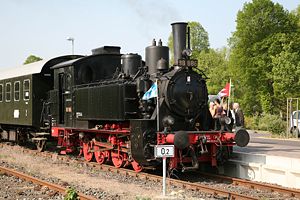Bavarian GtL 4/4
| GtL 4/4 (Bavaria), LAG no. 80–81 DR series 98 8–9, 16 |
|
|---|---|
|
98 886
|
|
| Numbering: | DR 98 801-917, 1601-1602 |
| Number: | 119 |
| Manufacturer: | Krauss |
| Year of construction (s): | 1911-1927 |
| Retirement: | 1970 |
| Type : | D h2t |
| Gauge : | 1435 mm ( standard gauge ) |
| Length over buffers: | 9250 mm; 9400 mm * |
| Service mass: | 43.0 t - 46.7 t |
| Friction mass: | 43.0 t - 46.7 t |
| Wheel set mass : | 10.8 t |
| Top speed: | 40 km / h |
| Indexed performance : | 331 kW / 450 PSi |
| Starting tractive effort: | ~ 101 kN |
| Driving wheel diameter: | 1006 mm |
| Number of cylinders: | 2 |
| Cylinder diameter: | 508 mm |
| Piston stroke: | 460 mm |
| Boiler overpressure: | 12 bar |
| Number of heating pipes: | 89 |
| Number of smoke tubes: | 12 |
| Heating pipe length: | 3500 mm |
| Grate area: | 1.36 m² |
| Radiant heating surface: | 5.85 m² |
| Tubular heating surface: | 55.14 m² |
| Superheater area : | 18.93 m² |
| Evaporation heating surface: | 60.99 m² |
| Water supply: | 5.4 m³ |
| Fuel supply: | 1.8 tons of coal |
| Locomotive brake: | Air brake |
| * 98 901-917 | |
The locomotives of the class GtL 4/4 were superheated steam locomotives of the Bavarian State Railways for use on local railways .
history
The vehicles were delivered to the state railway by Krauss . Two machines were built in 1911 and a further eleven in 1914. They were developed by Richard von Helmholtz .
Based on the positive experience with the GtL 4/4, the Bavarian Group Administration of the Deutsche Reichsbahn decided to purchase more copies of this locomotive. From 1921 to 1927 Krauss delivered another 108 machines, which were a little heavier and differed in the design of the driver's cab from the original 13 examples. The last 17 locomotives from 1927 were again heavier than the previous machines, which was due to the increased stocks. Boiler, engine and power remained unchanged over the entire procurement period.
On the Reichsbahn, the locomotives were classified as the 98 8–9 series with the numbers 98 801 to 98 917.
29 GtL 4/4 were modified between 1934 and 1941 by equipping them with a front Bissel axle and thus converting them to 1'D locomotives. The converted locomotives, also known as GtL 4/5, were classified in the 98 11 series. The aim of the conversion was to improve the running properties, the permissible speed could be increased from 40 to 55 km / h.
The LAG also procured two GtL 4/4s in 1922, which corresponded to the state railway version of 1921. The locomotives with the lane numbers 80 and 81 were at Bw Thalkirchen on the Isartalbahn located. They stayed there even after the takeover by the Reichsbahn. Unlike the other GtL 4/4, they were classified in the 98 16 series and were given the numbers 98 1601 and 98 1602.
During the Second World War five locomotives were destroyed, another three remained with the former Czechoslovak state railway ČSD .
The remaining machines came to the Deutsche Bundesbahn , which began retirement in the 1950s.
98 1101 was eliminated from the vehicle fleet due to an unusual accident on the Strullendorf – Schlüsselfeld railway on February 28, 1954 : At Sambach, the locomotive, which was driving a passenger train on that day, collided with an escaped ox , derailed and overturned the seven meter high one Down the embankment, as well as the fully occupied first car of the train. Nine passengers suffered injuries, some of them serious, and a member of the locomotive crew was burned by glowing coal. The property damage amounted to about 130,000 DM ; the locomotive was so badly damaged by the fall that it was scrapped.
The two LAG machines came to the Rosenheim depot in 1950 and were retired in 1957 and 1958.
The two locomotives 98 812 and 886 received EDP company numbers in 1968, but were retired a little later. 98 886 then served as a heating locomotive until 1975 . The 98 812 was raffled in 1970 (“Stars of the Rail” raffle) and reached the Ulm Railway Friends via a student , where it is available on wheels .
After being used as a heating locomotive, the 98 886 locomotive was erected in 1978 as a memorial in front of Schweinfurt Central Station . After the Streutalbahn was reactivated as a museum railway line, it was removed from the monument base and had it processed from 1999 to 2000 at DLW Meiningen. Since then it has been successfully in use again in front of the Rhön-Zügle from Mellrichstadt to Fladungen .
construction
The superheated steam locomotives had two cylinders. The chassis had side-shifting Gölsdorf axles . The Reichsbahn replicas were given closed driver's cabs and slightly enlarged water tanks. From 1922 the front windows were oval, the driver's cab got a ventilation attachment and the coal box an attachment.
literature
- Wolfgang Bleiweis: Museum locomotive 98 886 - the most successful four-coupler for local railways. H + L publications W. Bleiweis, Schweinfurt 2000, ISBN 3-928786-78-4
- Franconian Open Air Museum Fladungen: The Rhön-Zügle 2010
gallery
Web links
Individual evidence
- ↑ MIBA 4/1954, p. 151
- ↑ Christian Lindecke: Lokodex. Retrieved September 9, 2017 .
- ↑ Manuela and Georg Fischer: Burgebrach station - current events. Retrieved September 9, 2017 .
- ^ A b Ingo Hütter: The online vehicle database on the Internet. Retrieved March 9, 2010 .








